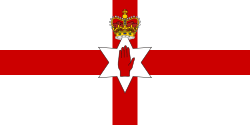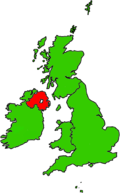Northern Ireland flags issue
The Northern Ireland flags issue is one that divides the population along sectarian lines. Depending on political allegiance, people identify with differing flags and symbols, some of which have, or have had, official status in Northern Ireland.
Common flags

The flag of the United Kingdom, the Union Flag, is the only official flag, and is routinely used on British government and some council buildings in Northern Ireland.[1] It is made from an amalgamation of the crosses of St. George (representing England), St. Andrew (representing Scotland) and St. Patrick (representing Ireland).
The Union Flag is often flown by unionists and loyalists but is disliked by nationalists and republicans.
The Ulster Banner, the flag of the pre-1973 government of Northern Ireland, was used from 1953 to 1972 by the Stormont government to represent the government of Northern Ireland.[2] That government was dissolved under the Northern Ireland Constitution Act 1973 and its flag ceased to have any official status. It continues to be used by some sports teams representing Northern Ireland internationally, for example by the Northern Ireland football team,[3] and by the Northern Ireland Commonwealth Games team.[4]
British law and policy states that in Northern Ireland, "The Ulster flag and the Cross of St. Patrick have no official status and under the Flags Regulations are not permitted to be flown from Government Buildings."[5]
The flag of Ireland or Irish tricolour is the state flag of the Republic of Ireland, and is regarded by many republicans and some nationalists as the flag of all of Ireland.
Other flags flown by socialist republicans include the Starry Plough and the Sunburst flag. Loyalists sometimes display the flag of Scotland as a sign of their Scottish ancestry.
Controversies
The Flags and Emblems (Display) Act (Northern Ireland) 1954 prohibited the display of any flag which was "likely to cause a breach of public order", and gave the police powers to deal with it. However, it specifically excluded the Union flag from its provisions.[6] In 1964, police moved in to remove an Irish tricolour from the window of an office in the Falls Road, after Ian Paisley had publicly said that if they did not, he would do so personally. This resulted in serious rioting.[6] The Act was repealed in 1987.
The flying of the Irish Tricolour by nationalists in Northern Ireland on St. Patrick's Day has caused some controversy, with unionists arguing that St. Patrick is the patron saint of the whole of Ireland, not just the Republic of Ireland or its citizens. Nationalists, however, argue that the flag represents all of Ireland, point to its intended meaning of peace (white) between both nationalist (green) and unionist (orange), and argue that there is no official flag at present for the whole of Ireland. Nationalists believe that there should not be a problem with flying the Tricolour on this day as unionists fly the former flag of the Northern Ireland Government (the Ulster Banner) during the 12 July celebrations. The Twelfth, however, is an overtly unionist event, whereas St. Patrick's Day is regarded as a non-political occasion.
In some loyalist areas the flying of flags supporting loyalist paramilitaries has proved controversial. Groups like the Ulster Defence Association, Ulster Freedom Fighters, Ulster Volunteer Force, Young Citizen Volunteers, Red Hand Commando, and Loyalist Volunteer Force all have their own unique flags and although these flags usually appear alongside murals, they can occasionally be seen flying from lampposts in villages and towns or even flying from households in the run up to The Twelfth.
Some local councils have debated the usage of the Tricolour. In 2002 Belfast City Council displayed the Tricolour along with the Union Flag in the Lord Mayor's parlour during the term of Sinn Féin Lord Mayor Alex Maskey.[7] Conversely in 1997, when the Social Democratic and Labour Party's (SDLP) Alban Maginness was Lord Mayor neither flag was displayed. In September 2003 Belfast City Council discussed flying the Tricolour alongside the Union Flag on designated occasions.
The Ulster Banner continues to be used by some local governments, such as the predominantly unionist Castlereagh, which flies it outside its offices.[8]
A decision in December 2012 to fly the Union flag over Belfast City Hall only on certain designated days, instead of all the year round as previously, led to protests which included riots in which police officers were injured.[9]
The Haass Talks
In 2013, US diplomat Richard Haass chaired talks between the political parties in Northern Ireland dealing with, among other things, the issue of flags. The resulting draft proposals, which were not agreed by the parties, included the idea of a new flag for Northern Ireland and the possibility of a "circumscribed role for the sovereign flag of Ireland in conjunction with the Union flag."[10]
See also
- Party Processions Act 1850 Act which banned "any Banner, Emblem, Flag or Symbol, the Display whereof may be calculated or tend to provoke Animosity between different Classes of Her Majesty's Subjects"
- Flag of Northern Ireland
- List of flags of the United Kingdom
- List of flags used in Northern Ireland
- List of flags of the Republic of Ireland
References
- ↑ "The Flags Regulations (Northern Ireland) 2000" (PDF). Northern Ireland Assembly. Retrieved 5 October 2011.
- ↑ Encyclopaedia Britannica says: According to British tradition, a coat of arms or flag is granted to the government of a territory, not to the people residing there
- ↑ "Northern Ireland". FIFA. Retrieved 5 October 2011.
- ↑ Commonwealth Games website. Choose "Northern Ireland" from the "Countries" menu.
- ↑ "The Union Flag and Flags of the United Kingdom" (PDF). Parliament of the United Kingdom. Retrieved 5 October 2011.
- ↑ 6.0 6.1 Thomas Hylland Eriksen and Richard Jenkins, Flag, Nation and Symbolism in Europe and America, Routledge, 2007, ISBN 1134066961, p. 104
- ↑ "Tricolour raised in City Hall". BBC. 4 September 2002. Retrieved 2012-07-27.
- ↑ Castlereagh (1 January 1970). "Castlereagh Borough Council, Northern Ireland". Maps.google.com. Retrieved 26 September 2011.
- ↑ Belfast flag protests: Loyalists clash with police after rally, BBC, 8 December 2012
- ↑ John Mulgrew, "Final draft on dealing with Northern Ireland's past released after failure on agreement", Belfast Telegraph, 31 December 2013. Retrieved 28 January 2014
External links
- Symbols in Northern Ireland - Flags Used in the Region by Dara Mulhern and Martin Melaugh; illustrated article from CAIN Project (Conflict Archive on the INternet)
| |||||||||||||||||||||||||||||||||||||||||||||||||||||||


